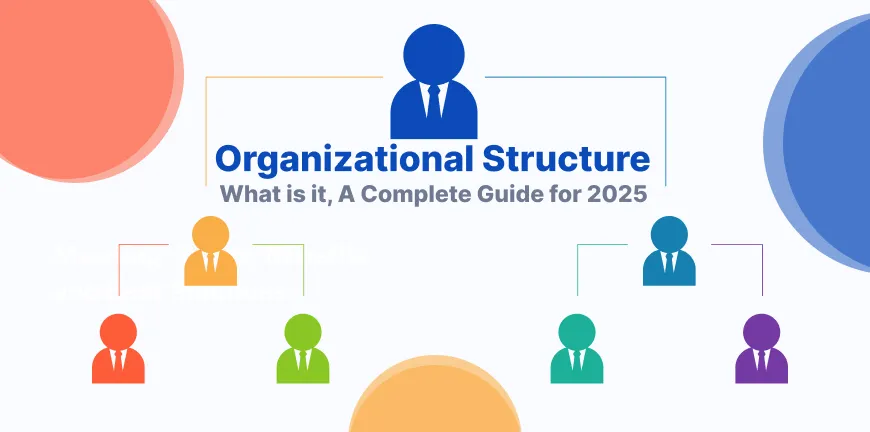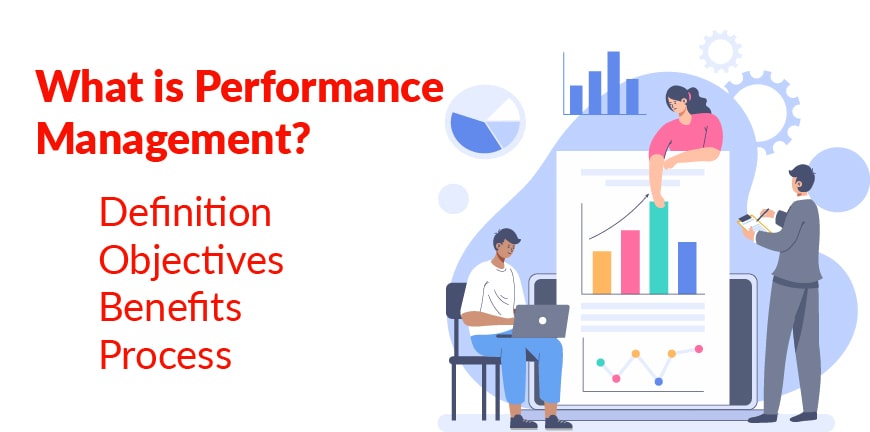
What Is IT Staff Augmentation? Meaning, Types, Benefits, and Best Practices
13/10/2025
8 Key Leadership Principles for Managers to Excel in the Workplace
13/10/2025- What is Organizational Structure? Meaning and Definition
- What is the Importance of Organizational Structure?
- What are the Types of Organizational Structures?
- How to Choose the Right Organizational Structure
- What are the Benefits of an Effective Organizational Structure?
- What are the Challenges in Organizational Structure
- Future Trends in Organizational Structures
- Frequently Asked Questions
An organizational structure is a set of rules that helps a company organize its employees. It also orders how all employees must work together. Organizational structures are essential as they provide rules that facilitate the proper functioning of the organization and promote appropriate, efficient interactions with employees. It also helps communicate properly with customers and stakeholders, the ones who play a crucial role in deciding the future of the organization. In this article, we’ll see in detail about the types of organizational structures, how they work, key elements, and more.
What is Organizational Structure? Meaning and Definition
Organizational structure refers to the entire setup of the company. It encompasses how every department works, management of hierarchy, and decision-making. This well-thought-out framework helps them achieve their goals. Departments organize function, product, geography, or a combination of these. Most companies have separate business units where each unit has its own sales and marketing teams. They may also have dedicated production facilities depending on the growth and needs of the company. Management structure delegates leadership authority and determines how communication happens within a company. The organizational structure of a company makes decision-making and effective coordination possible. It helps determine how the company allocates resources.
What is the Importance of Organizational Structure?
To serve various markets, make profits, and create value for shareholders, businesses must have an organizational structure that facilitates the smooth delivery of strategy. Everything must work in sync and smoothly. How can you make this happen? By having the right people doing the right jobs. Poor organizational structure can create chaos and disrupt most of the functions and operations. The symptoms that indicate this are lower innovation, average execution, missed deadlines, high costs, poor performance, high turnover, and low engagement.
Organizational structures provide a clear chart that helps businesses keep track of their human resources. A functional organizational structure can be seen in how well a company is operating and delivering results.
- Facilitates swift strategic delivery, business plan achievement, and growth in profits
- Sparks should focus on core activities that translate into profits and revenue-generating tasks
- Every role is performed better with fewer costs incorporated into it
- Higher employee retention and enhanced talent development
- Employees have a better capacity to focus on innovation on every level, leading to better growth. This instils a sense of trust in current and future potential shareholders.
What are the Types of Organizational Structures?
There are several types of organizational structures. Each of these structures is developed to help organizations of various sizes, with unique business needs, streamline their operations and achieve their goals.
1. Hierarchical organizational structure
This is one of the most common types of organizational structures. It’s a traditional structure that is designed like a pyramid. It has a transparent chain of command where every employee has a supervisor. Authority flows from the top levels of management down to the lower levels.
Advantages include-
- Clear leadership roles and levels
- Better development and promotion opportunities
Disadvantages include-
- Lesser collaboration and innovation
- Bureaucracy must be managed
2. Functional organizational structure
Similar to the hierarchical organizational structure, this approach has individuals in positions with a higher responsibility and others who work under these leaders. Employees who work under these leaders are categorized based on their skills and work in a specific department. These departments are managed independently.
Advantages of this structure include-
- clear roles and expectations defined
- better performance and productivity
- Develops skills
Disadvantages include
- Functional barriers
- Stifles communication with other departments
- Less teamwork and innovation
3. Horizontal or flat organisational structure
This is a structure where there aren’t that many leadership or management levels between the leaders and staff level employees. Mostly, startups and mid-level companies use this structure before they expand or form many departments.
Advantages include-
- Employees have a better sense of responsibility
- Gives way to better communication
- Helps with better coordination and implementation of ideas
Disadvantages include-
- May create confusion among employees as to who they are to report to
- This structure won’t work once the company grows and has many employees and departments.
4. Divisional organizational structure
Every division in the company takes control of its resources and how it uses and spends them. This is how it works in bigger organizations. Various divisions can make decisions about the teams they want, such as marketing, sales, etc.
Advantages include-
- They help companies stay flexible
- Can receive faster responses
- Fosters independent decision-making
Disadvantages include-
- Leads to duplicate resources
- Broken communication between headquarters and divisions
5. Matrix Organizational Structure
It looks like a grid and shows cross-functional teams that form for special projects. For example, an engineer who generally works on tasks in the engineering department may work temporarily on a project led by a project manager.
Advantages include-
- Facilitates identifying and picking individuals based on the needs of a project
- Offers a clearer view of the organization
- Encourages employees to work on different projects other than their own duties and tasks.
Disadvantages include-
- Can create conflicts of interest between department managers and project managers
6. Team-based organizational structure
In this structure, employees are grouped according to teams. It helps in faster problem-solving and co-operation and allows better control.
Advantages
- Enhanced productivity, performance, and transparency
- Experience is given more value than seniority
- Needs minimal management
- Perfect for agile companies that have structured teams
Disadvantages
- Opposes the traditional, natural inclination that is present in a hierarchical structure
- Promotions and progression in the career path are a bit chaotic
7. Network organizational structure
Businesses these days juggle with individuals offering various services, such as vendors, subcontractors, freelancers, and off-site locations. This structure helps streamline communication, make sense, and utilize the resource correctly.
Advantages
- Helps understand the complexity of the relationships
- Allows for higher agility and flexibility
- Allows all employees to take initiative and make decisions
Disadvantages
- Dealing with multiple service providers can get complex and chaotic
- Makes it difficult for employees to know who has the final say
8. Process-based structure
Employees are grouped into departments based on the steps of a process. This means there are different processes going on in the organization, and each step of the process has a supervisor and employees working in that process.
Advantages-
- Faster and more efficient processes
- Better teamwork within and across departments
Disadvantages-
- Leads to barriers between departments
- Miscommunication
9. Circular structure
In a circular organizational structure, leaders are present at the centre of the organization rather than at the top. This allows the leaders to pass on information to various departments and teams.
Advantages-
- Better passing of information across the organization
- Fosters communication and collaboration between employees and departments
Disadvantages-
- May cause confusion among employees regarding who they are to report to
- Decision-making can take longer
10. Line structure
This is a straightforward structure, where each department is led by a manager and works toward a common organizational objective.
Advantages-
- Clear reporting structures
- Streamlined environment
Disadvantages-
- Can be inflexible
- Limits innovation
The above-mentioned are the various examples of organizational structures. Companies, based on their size, industry, and needs, use one of these organizational structures to streamline their operations.
How to Choose the Right Organizational Structure
Choosing the proper organizational structure is instrumental in helping decide how it can achieve its goals.
1. Understand the different organizational structures
Know about the different types of organizational structures and how they work. Based on your company’s size, various departments, functional requirements, etc, you can choose the structure that works best for you.
2. Determine the company’s strategy
After understanding how different organizational structures work, you must map out your company’s long-term goals and plans. To do this, you must be clear about the mission and vision of the company. Choose a structure that helps realise the organization’s long-term plans. For example, a startup will have a different strategy than that of a corporate company, as the number of employees varies, may have fewer/more departments, etc. So, they’ll have different organizational structures requiring distinct strategies.
3. Consider the size of the business environment
Some businesses are fast-paced, and some are not so much. Knowing your company’s dynamics is the first step, as it can help determine the organizational structure that works best for you. For example, startups that are growing would benefit from flexible and adaptable environments. A smaller company achieves this easily with a decentralized structure, where employees are also given the power to make decisions. On the other hand, larger companies would require a hierarchical structure as it may require a more stable environment.
4. Review the information
Based on the company’s strategy, environment, size, and age, you can analyse what the company can benefit from. Whether a centralized, organic, or decentralized approach is right for you. Based on this, you can bring your options down to two or three structures that could be right for your company.
5. Create a chart and make a decision
Once you have your final options, create a visual with all the information so that you can understand the structure that fits right. Make a chart that has information like names of employees, what their responsibilities are, whether you need to add more employees to a particular team or department, and whether you need a manager to manage these teams. Based on all this, you can decide whether the organizational structure is perfect for you.
What are the Benefits of an Effective Organizational Structure?
The organizational structure helps organizations delegate the right degree of authority to employees working at different levels. This delegation helps smooth the workflow, as there is no confusion as to who they report to, what their roles and responsibilities are, and how they can contribute to business goals.
- The right organizational structures clearly define the distinct roles and responsibilities of employees working at different levels. This reduces confusion among employees.
- The right structure not only helps with the right hierarchy but also improves workflow and task allocation, leading to increased productivity.
- The proper structure can adapt to changes in the business environment and allow for innovation.
- Clearly defined roles make it easier to hold individuals and teams accountable for their performance.
What are the Challenges in Organizational Structure
Balancing centralization and decentralization, which can lead to quick or slow decision-making, communication issues, etc., are some of the challenges in organizational structure.
1. Balance of structural components
If you have an extremely centralized structure, it can lead to slower decision-making. However, a decentralized structure can lead to making wrong decisions as the power is distributed and no one person has control. Dividing tasks among different departments and maintaining coordination to ensure proper work output is challenging. Figuring out the right structure can be confusing.
2. Communication and coordination
The wrong organizational structure can lead to stifling of communication, lower customer satisfaction. It can also result in unsatisfactory work outputs due to less coordination between different teams and departments.
3. Adapting to change and growth
Hierarchical structures may work for some of the bigger organizations with a set flow of operations, but also make it less easy to adapt to changes. The fast growth of organizations can make it difficult to ensure that employees’ tasks are aligned with organizational goals. Allocating resources properly can become a pain.
4. Employee and leadership issues
Without a proper vision, motivation among employees can drastically reduce. Poor leadership can lead to insufficient work, further lessening employee morale. Some of the organizational structures may not be the best for helping employees make decisions about their career advancement.
Future Trends in Organizational Structures
- Flatter management structures are more sought after as they facilitate faster decision-making and ensure better communication between employees.
- Employees are encouraged to take up different assignments and projects other than what they do on a daily basis. This encourages upskilling.
- Remote work is the norm today. Networked structures can support this. By using the right technology, the performance and productivity of employees are maintained.
- Rather than higher-level or fancy job titles, roles are being designed based on the skills of employees. This is paving the way for a more inclusive mentality.
- Using AI tools to analyse data, streamline workflows, and make better decisions is a priority.
- Making sure employees have access to wellness programs, offering flexible schedules, and resources has helped increase productivity.
Frequently Asked Questions
1. What is an organizational structure in management?
An organizational structure is a system that defines how activities are managed and directed to achieve an organization’s goals.
2. What are the 5 main types of organizational structure?
Functional, divisional, matrix, network, and hierarchical structures are the most common types of organizational structures.
3. Why is organizational structure important?
Organizational structure can help companies ease the workflows, streamline operations and use resources effectively.
4. What is an example of organizational structure?
Hierarchical, functional, and divisional are some examples of organizational structures.
5. How do you choose the best organizational structure?
Based on your company’s size, operational needs, departments, and the need to add teams or departments, you can choose an organizational structure that supports all of these requirements.
6. What is the difference between functional and matrix structure?
A matrix organizational structure is a hybrid approach that combines elements of both functional and project-based structures.
Contact Us For Business Enquiry

Rajkumar Shanmugam
Rajkumar Shanmugam is the Head of HR at ALP Consulting, bringing over 19 years of comprehensive HR leadership experience across India and international markets. His expertise spans talent acquisition, employee relations, performance management, compliance, and HR transformation. Rajkumar has a proven track record of driving people-centric initiatives, enhancing workplace culture, and aligning HR strategy with business goals. With extensive experience in US staffing operations and global mobility, he continues to lead organizational excellence through innovation and employee engagement.




